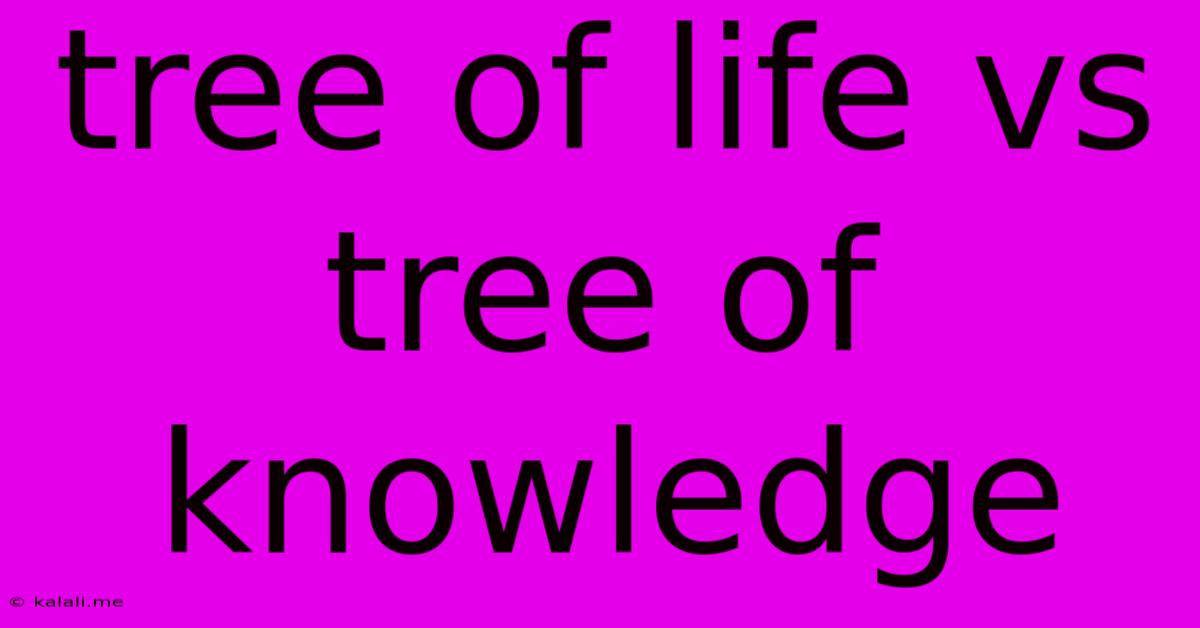Tree Of Life Vs Tree Of Knowledge
Kalali
Jun 07, 2025 · 3 min read

Table of Contents
Tree of Life vs. Tree of Knowledge: A Deep Dive into Biblical Symbolism
The Tree of Life and the Tree of Knowledge of Good and Evil are two iconic symbols from the Book of Genesis, captivating theologians, philosophers, and artists for millennia. While both reside within the Garden of Eden, their meanings and implications are vastly different, representing fundamental choices and consequences within the human experience. This article delves into the contrasting symbolism of these two trees, exploring their significance in religious interpretations and their enduring legacy in literature and art.
Understanding the Context: The Garden of Eden
The Garden of Eden, a paradise described in Genesis 2, is a space of perfection, abundance, and divine presence. Central to this idyllic setting are two trees: the Tree of Life, representing immortality and divine connection, and the Tree of Knowledge of Good and Evil, representing the potential for self-awareness, morality, and ultimately, the consequences of choice. The narrative surrounding these trees lays the foundation for understanding humanity's relationship with God and the complexities of free will.
The Tree of Life: Immortality and Divine Connection
The Tree of Life, often depicted as a lush, vibrant tree, symbolizes immortality, eternal life, and direct communion with God. Eating from its fruit would grant the eater perpetual life and sustained connection to the divine source. Its presence in the Garden represents the perfect state of humanity before the Fall, a state of innocence and unbroken fellowship with the Creator. The Tree of Life's imagery evokes themes of paradise, regeneration, and the promise of everlasting life, frequently appearing in religious art and literature as a symbol of hope and spiritual aspiration. Many different interpretations exist, some linking it to the concept of spiritual nourishment and ongoing renewal.
Key aspects of the Tree of Life:
- Immortality: Access to unending life.
- Divine Connection: Direct relationship with God.
- Perfection: Representation of an unblemished state.
- Renewal: A symbol of ongoing spiritual growth.
The Tree of Knowledge of Good and Evil: Self-Awareness and the Fall
In stark contrast to the Tree of Life, the Tree of Knowledge of Good and Evil represents self-awareness, moral understanding, and the capacity for choice. While seemingly offering knowledge and empowerment, its fruit ultimately leads to the "Fall" – the expulsion of Adam and Eve from the Garden of Eden. This expulsion symbolizes the loss of innocence, the introduction of suffering, and humanity's separation from the divine. The tree highlights the complexities of free will: the ability to choose between obedience and disobedience, and the ensuing consequences. The fruit is not inherently evil; rather, it represents the potential for both good and evil inherent in human consciousness.
Key aspects of the Tree of Knowledge:
- Self-Awareness: Understanding of morality and consequences.
- Choice and Free Will: The ability to choose, resulting in responsibility.
- The Fall: The loss of innocence and divine connection.
- Mortality: Acceptance of the human condition, including death.
Comparing and Contrasting the Two Trees
The juxtaposition of these two trees underscores a fundamental theological tension: the desire for knowledge versus the pursuit of innocence and divine unity. The Tree of Life represents the blissful state of being before the Fall, a condition of dependence and trust in God. The Tree of Knowledge represents the human ambition to understand and control one's destiny, a desire that leads to both enlightenment and suffering. Ultimately, the narrative suggests that the pursuit of knowledge, while essential for human growth, comes at a cost, requiring a sacrifice of innocence and a greater understanding of mortality and the consequences of choice.
Enduring Legacy and Interpretations
The symbolism of the Tree of Life and the Tree of Knowledge continues to resonate deeply in various religious and cultural contexts. These powerful images appear in art, literature, and philosophy, inspiring countless interpretations and explorations of human nature, morality, and spirituality. Their enduring legacy highlights the ongoing human struggle between the desire for knowledge and the longing for connection with something greater than ourselves. The narratives offer a framework for understanding the complexities of human existence and the enduring quest for meaning and purpose.
Latest Posts
Latest Posts
-
Can Enderman Spawn On Endstone Bricks
Jun 07, 2025
-
How Do You Find The Maximum Profit
Jun 07, 2025
-
Combine Tankless And Tank Water Heaters
Jun 07, 2025
-
Why Did God Wrestle With Jacob
Jun 07, 2025
-
Freertos Context Switch Implementation On Arm
Jun 07, 2025
Related Post
Thank you for visiting our website which covers about Tree Of Life Vs Tree Of Knowledge . We hope the information provided has been useful to you. Feel free to contact us if you have any questions or need further assistance. See you next time and don't miss to bookmark.